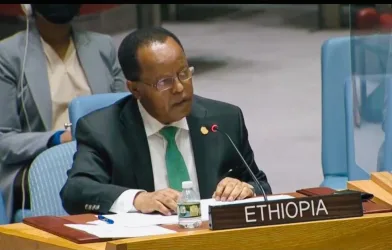 Mohamed Olhaye Nour, 60, last cultivated his farm in Abuda, 24km southwest of Somaliland’s capital, Hargeisa, more than two decades ago.
Mohamed Olhaye Nour, 60, last cultivated his farm in Abuda, 24km southwest of Somaliland’s capital, Hargeisa, more than two decades ago.
“Before the war, our life was good; we did not worry about making ends meet,” he said. “In an average year, our crop production was about 40-50 `jawan’ (one `jawan’ = 100kg sack of maize and sorghum mixed together).
“We kept 15-20 `jawan’ in reserve. We used the remainder in different ways, such as for bread, ‘African cake’ [maize meal] eaten with milk, or sorghum with milk.”
Nour, who has two wives and 17 children, stopped cultivating his land because it “is full of mines”. Two people who ventured onto the land got injured – one losing both arms. Nour has also lost 36 livestock to the mines.
Most of the unexploded ordnance (UXO) in Abuda was planted during the 1977-78 war between Somalia and Ethiopia, according to local residents. Some is from the 1981-91 war between the Somali National Movement and the Somali National Army.
According to Nour, many residents of Abuda were agro-pastoralists before these wars. Most fled to Ethiopia when clashes first broke out. When they returned in 1991, they found their farmland had been mined. Now they mostly survive as livestock keepers.
An anti-tank mine: Experts say more than 250,000 pieces of unexploded ordnance, including anti-personnel and anti-tank mines, are buried in
Experts in the self-declared republic say more than 250,000 pieces of unexploded ordnance, including anti-personnel and anti-tank mines, are buried in Somaliland.
UXO is scattered across northwestern Somalia, from Elayo to Loyada and from Bihen to Gestir.
Demining
Over the years, farmers wrote many letters to the Somaliland government requesting that the Abuda area be demined, Nour said. In 2009, the UK-based organization HALO Trust started demining farmland in this area.
Hargeisa, according to HALO, was heavily mined around military bases, refugee camps, private houses and the airport. The war between Ethiopia and Somalia also left behind large amounts of unexploded ordnance.
Some UXO has, unfortunately, been harvested from mines for illegal reuse. This is particularly the case with anti-tank mines and explosive ordnance. Another problem is that most mines in Somaliland are plastic-bodied, making them difficult to locate using conventional demining equipment, according to HALO.
“We started demining operations in this area [Abuda] in early November 2009 after we received complaints from residents,” said Hassan Kosar, operations officer for HALO in Hargeisa. “We hope to finish in early May 2010, if we have adequate manpower capacity.”
Mohamed Olhaye Nour points at his farm, which he says is heavily mined
Two other mine clearance institutions now exist in Somaliland – the Mine Action Center and the National Demining Agency.
HALO is currently supporting the National Demining Agency to expand mine-clearing operations, because the Somaliland government’s budget for demining institutions is limited.
“This is the first time a local institution is going to engage in mine clearance operations in Somaliland after HALO Trust trains 40 deminers for us,” said Mohamed Were, operations officer for the Somaliland National Demining Agency. “[But] our problem is lack of funds.”
At least eight hectares owned by 95 families in the Abuda area were mined, as well as several hectares further to the north.
“I have not cultivated my farm since 1988 but now that demining is going on, I hope the clearing of our farms will be completed before the rains come,” Nour told IRIN.
 Source: IRIN
SOMALIA: My farm "is full of mines"
Published: February 2, 2010







